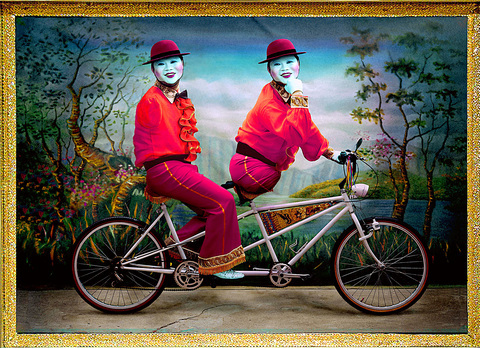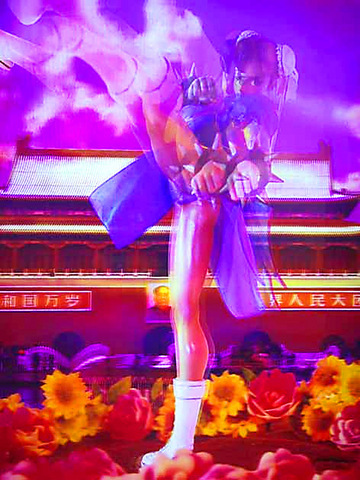If you didn't make the gala party last week at the British Trade and Cultural Office Residence in Yangmingshan, the first time an exhibition of local art has been shown at a diplomatic residence, you can still see the avant-garde art that was exhibited and which is now being shown at the Taipei MOMA Gallery.
Entitled A Peep into Taiwanese Contemporary Photography the exhibition brings together several of the hottest Taiwanese artists working today.
The party was an important event as it merged two audiences that normally do not cross paths: those working in the foreign services and those in the art world. The exhibition helped to broaden the audience for the local art while also highlighting the importance of cultural exchanges.

PHOTOS COURTESY OF TAIPEI MOMA
The concise exhibition at the gallery contains digital imagery, video and photographs by some of the top Taiwanese artists and provides a general overview of what is happening currently in art. This is a great opportunity to see the work of some of the best artists in Taiwan.
For some flashy images, Hung Tung-lu's (
Wu Tien-chang's (

On view are two video works that range from deeply somber to sidesplitting slapstick. Chen Chieh-ren's (
In contrast, the lighthearted and humorous videos of Tsui Kuang-yu (
Taipei MOMA Gallery is at 3F, 19, Ln 252, Dunhua S Rd, Sec 1, Taipei (
Besides this, there are several exhibitions about town. If you're still in a photographic mood, then go to TIVAC to see its current show of Taiwanese and German photographers. Taiwan International Visual Arts Center, 1 F, 29, Ln 45, Liaoning Street (
Song of the Wanderer -- Taiwan German Photography Exhibition includes work by Ulrike Myrzik and Manfred Jarisch, with the theme "Architecture of the Homeless." Ho Ching-tai (
At the Main Trend Gallery there is a solo show by Chang Chen-jen (
Taking place simultaneously, in Kaohsiung at the Sin Pin Pier and at the Birmingham Institute of Art and Design in Birmingham, England, Seesaw is a conceptual art exhibition that tries to merge two time-zones via digital art. The exhibition includes the work of UK artists and of Taiwanese artists. Since the works are electronic, they disappear when switched off; therefore the art seesaws between the two cities separated by an eight-hour time difference.
Hsu Su-chen (

In the March 9 edition of the Taipei Times a piece by Ninon Godefroy ran with the headine “The quiet, gentle rhythm of Taiwan.” It started with the line “Taiwan is a small, humble place. There is no Eiffel Tower, no pyramids — no singular attraction that draws the world’s attention.” I laughed out loud at that. This was out of no disrespect for the author or the piece, which made some interesting analogies and good points about how both Din Tai Fung’s and Taiwan Semiconductor Manufacturing Co’s (TSMC, 台積電) meticulous attention to detail and quality are not quite up to

April 21 to April 27 Hsieh Er’s (謝娥) political fortunes were rising fast after she got out of jail and joined the Chinese Nationalist Party (KMT) in December 1945. Not only did she hold key positions in various committees, she was elected the only woman on the Taipei City Council and headed to Nanjing in 1946 as the sole Taiwanese female representative to the National Constituent Assembly. With the support of first lady Soong May-ling (宋美齡), she started the Taipei Women’s Association and Taiwan Provincial Women’s Association, where she

Chinese Nationalist Party (KMT) Chairman Eric Chu (朱立倫) hatched a bold plan to charge forward and seize the initiative when he held a protest in front of the Taipei City Prosecutors’ Office. Though risky, because illegal, its success would help tackle at least six problems facing both himself and the KMT. What he did not see coming was Taipei Mayor Chiang Wan-an (將萬安) tripping him up out of the gate. In spite of Chu being the most consequential and successful KMT chairman since the early 2010s — arguably saving the party from financial ruin and restoring its electoral viability —

It is one of the more remarkable facts of Taiwan history that it was never occupied or claimed by any of the numerous kingdoms of southern China — Han or otherwise — that lay just across the water from it. None of their brilliant ministers ever discovered that Taiwan was a “core interest” of the state whose annexation was “inevitable.” As Paul Kua notes in an excellent monograph laying out how the Portuguese gave Taiwan the name “Formosa,” the first Europeans to express an interest in occupying Taiwan were the Spanish. Tonio Andrade in his seminal work, How Taiwan Became Chinese,